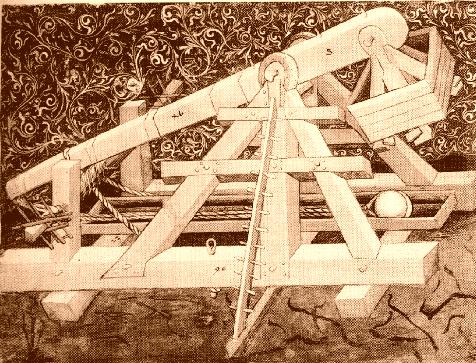About Trebuchets
Today, we think about guns, catapults, and human ingenuity. The University of Houston's College of Engineering presents this series about the machines that make our civilization run, and the people whose ingenuity created them.
No engine of our ingenuity is more basic than the lever. It takes a hundred different forms. One's the catapult -- a lever with two unequal arms. At the end of the short arm is either a rope or a large counterweight. At the end of the long arm is a sling. To hurl a projectile, you either pull the rope or release the counterweight.
Catapults grew out of a labor-saving gadget -- the counterbalanced bucket. A bucket on the long arm was partly balanced by a weight on the short arm. You gently forced the bucket down. Then you only had to lift part of the weight of water.
A story survives from 400 BC. The counterbalanced bucket was common by then. Yet one elderly Chinese refused to use it. As he hauled a pail back and forth, watering his garden, he complained about the counterbalanced bucket. It was a cunning device, he said, and people who use cunning devices have cunning in their hearts. Maybe he had a point. The Chinese soon made this work-saver into a savage war machine.
Dating the catapult is hard to do. Chinese writings use the word phao to describe anything explosive -- a rock leaving a sling, or a gun or firecracker. It's hard to be sure just what phao means when we see it. We know Chinese catapults were common by the 2nd century AD. But they could've been around long before -- even while that old man watered his garden 600 years before.
The catapult stayed in China until the 1200s. The Romans built a great armory of siege engines, but they never used catapults! Every Roman throwing machine was based on the bow and arrow. All their artillery looked like slingshots and crossbows.
Meanwhile the Chinese threw stones as heavy as a man. They threw them 300 feet. They flung fire, arrows, and finally explosives at their enemies. Chinese ships, armed with catapults, set out to invade Japan in the 13th century. When a storm stopped them, the Japanese called it a kamikaze -- a divine wind.
By then, Arabs had the catapult. We probably got it from them during the Crusades, but we only used it for a little while. We soon gave it up for another Chinese invention. In the 1300s, we took up firearms. It was then -- just then -- that a Chinese poet wrote this about the catapult:
The crags of the mountains, rounded by craft,
Are made to fly forth from the catch of a machine;
Through wind and clouds they ride upon their way,
Like shooting stars they thunder through space --
So this chapter in human ingenuity ends with a strange image: a poet celebrating the genius of the catapult in the very moment it gives way to a far more terrible engine of war -- the gun.
I'm John Lienhard, at the University of Houston, where we're interested in the way inventive minds work.
(Theme music)
For the simplicity's sake, I've used the familiar word catapult. Historians prefer to use the French word trebuchet. The correct term for the counterbalanced lifting device is swape. The swape lets you divide the force of lifting in two. Typically, to lift 80 pounds of water, you would push the bucket down into the water with a 40 pound force. Then it would take a 40 pound force in the other direction to lift the filled bucket.
My source on this is the great scholar of Chinese technology, J.H. Needham, who is also author of a five-volume series on Chinese technology:
Needham, J.H., China's Trebuchets, Manned and Counter Weighted. Humana Civilitas: Sources and Studies Relating to the Middle Ages and the Renaissance, Vol. I, On Pre-Modern Technology and Science (B.S. Hall, D.C. West, eds.). Malibu: Undena Publications, 1976.
I am grateful to Pat Bozeman, Head, Special Collections, UH Library, for drawing my attention to this uncatalogued source and making it available to me. For more on the trebuchet and for links to trebuchet websites, see Episode 593.
